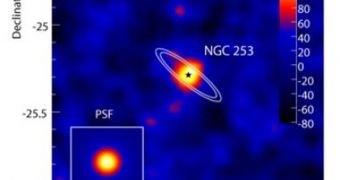For all its massive size, our galaxy, the Milky Way, is a bit slow when it comes to forming new stars. This is not the case with other large galaxies, which produce young, blue suns at very high rates. These areas of intense star production, known as stellar nurseries, have long been associated with radiation, and a recent investigation – conducted using the H.E.S.S. telescopes, shows that large amounts of gamma rays are emitted from within these structures. The recent measurements were conducted on the galaxy NGC 253, which is closely outside our own Local Group.
The reason why stellar nurseries emit this high-energy radiation has remained a mystery for quite some time, but astrophysicists have eventually figured it out. They have determined that, for the large number of stars that is created within the gas clouds, an equally large number of old stars dies. Some of these stars explode into supernovae, modifying the structure of the gas around them. But the catch is that these remnants in essence act like particle accelerators, forcing elementary particles to move at increasingly high speeds, until their energy reaches the gamma-ray wavelentgh.
The research, which is detailed in the September issue of the journal Science Express, also shows that the high-energy radiation originates at the core of the galaxies, in regions that naturally house the largest concentrations of supernovae. NGC 253, which is some 12 million light-years away from the Earth, was observed with the four H.E.S.S. telescopes, each with a mirror area of 108 square meters. They are extremely sensitive in detecting weak, bluish and extremely short flashes of light known as the Cherenkov radiation. This radiation is generated when high-energy gamma quanta collide with molecules in the Earth's atmosphere, generating a shower of particles.
Previous studies of this galaxy have been conducted in radio, infrared, and visible wavelengths, and the observations have hinted that the area at the core of NGC 253 is extremely active in forming young, blue stars. This happens because very high concentrations of cosmic dust and gas exist at the core. Under the right conditions, these clouds can collapse under their own weight, and ignite, giving birth to stars. Naturally, when these formations reach the end of their burning cycle, they either go out quietly (transform into white dwarfs), turn into a black hole or a neutron star, or explode into a supernova.

 14 DAY TRIAL //
14 DAY TRIAL //